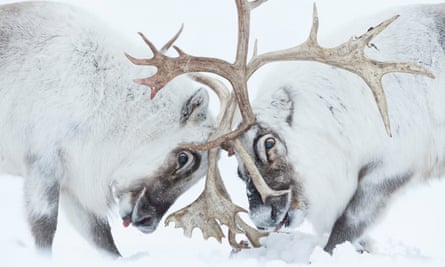Svalbard reindeer thrive as they shift diet towards ‘popsicle-like’ grasses | Wildlife
As the Arctic warms, concern for the plight of Santa’s favourite sleigh pullers is mounting. But in one small corner of the far flung north – Svalbard – Rudolph and his friends are thriving.
Warmer temperatures are boosting plant growth and giving Svalbard reindeer more time to build up fat reserves; they also appear to be shifting their diets towards “popsicle-like” grasses that poke up through the ice and snow, data suggests.
Smaller and plumper than their Lapplandish cousins, yet boasting impressive antlers nonetheless, Svalbard reindeer inhabit almost all non-glaciated areas of the Svalbard archipelago, which sits just 500 miles (800km) from the North Pole.
Like other Arctic regions, Svalbard has experienced thicker snowfall, and more frequent rain-on-snow events – where rain falls on an existing snowpack and freezes – in recent years, making it harder for reindeer to dig for food.
Reports of mass reindeer starvations in Russia, and declining caribou populations in Canada and Alaska, have also prompted concern for Svalbard’s reindeer. Yet, in the most productive parts of the archipelago, reindeer populations have flourished in recent decades.

To investigate what might be driving the population increase, Tamara Hiltunen, a doctoral student at the University of Oulu in Finland, and her colleagues turned to annual blood samples collected in late winter as part of a long-term monitoring study. By comparing the proportion of carbon and nitrogen isotopes in these samples, they could infer what kinds of plants the reindeer had been eating in preceding weeks.
The research, published in Global Change Biology, suggested that between 1995 and 2012 – a period marked by the normalisation of rain-on-snow events, increased summer temperatures and a growing reindeer population – there was a dietary shift away from low-growing mosses and towards grass-like “graminoid” plants.
“The erect nature of the graminoid stems allows that forage to be available to the animals, even though you might have a centimetre or so of ice,” said Prof Jeffrey Welker at the University of Oulu, who supervised the research. “You have the equivalent of popsicle sticks, which are nutritious enough that those animals can sustain themselves, even during these stressful periods of winter.”
Higher soil temperatures and greater amounts of reindeer droppings and urine falling on the ground are also boosting the growth of graminoids, which may further benefit the Svalbard reindeer.
“This is definitely encouraging news,” said Prof Jaakko Putkonen at the University of North Dakota, whose research previously predicted an increase in Arctic regions affected by rain as the century wears on. “However, nature is an endless web of interdependent variables. Some of the upcoming changes may be good to the reindeer and some may be detrimental.
“For example, from Scandinavia there are reports of rain on snow promoting the growth of fungi (eg toxic moulds) under the snowpack due to warmer conditions which has led the reindeer to avoid those areas. They may be trading one challenge for another one.”
Welker also cautioned that events in Svalbard may not apply to other regions of the Arctic.
“Just as we see signs that a reindeer population on Svalbard might have some ways of adapting and adjusting to these changes, that could allow them to sustain themselves, we’ve got other groups in Alaska, for instance, that are declining.
“It really speaks to the complexity of the Arctic. Events that are happening in one place are not identical to those that are happening in others.”
However, for Svalbard’s reindeer, the future looks bright – and the archipelago a promising recruitment ground should Santa need further helpers. Given their diminutive size, though, he may need to invest in a smaller sleigh.
“I’m sure they could do it, they just might be a little bit obese,” said Hiltunen. “But maybe if they lived with Santa, they wouldn’t need so much fat to keep themselves alive.”
